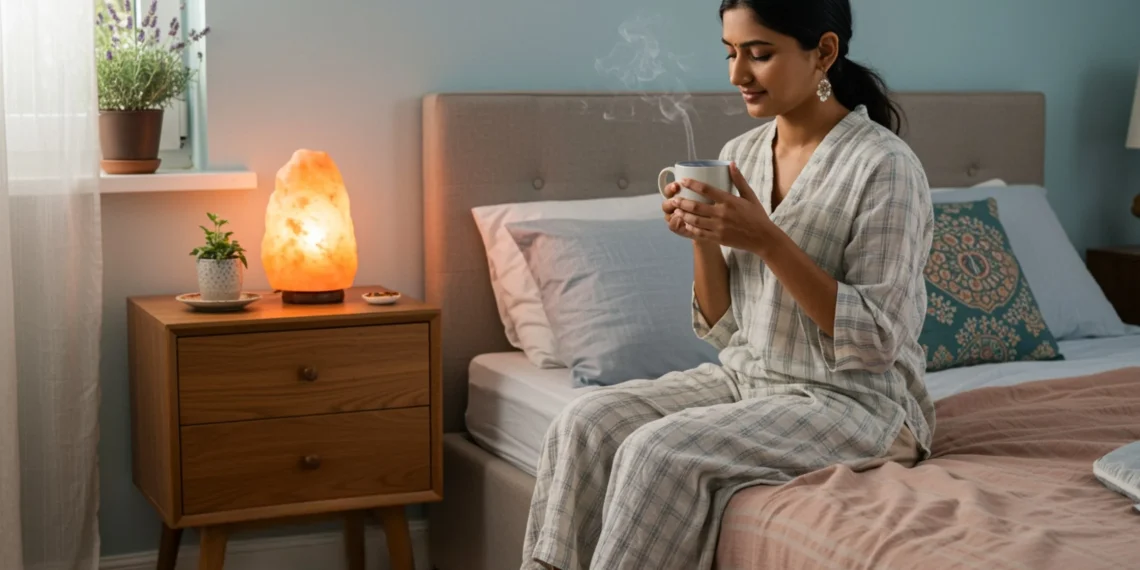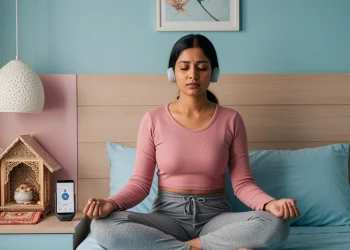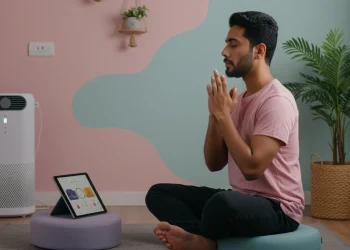When the world sleeps peacefully, but your mind races through endless thoughts, you’re not alone. Millions across India and globally struggle with sleep insomnia, seeking answers that bridge ancient wisdom with proven modern treatments.
Creating Your Personalized Insomnia Treatment Plan
The journey to overcoming chronic insomnia begins with understanding that no single solution works for everyone. Your unique constitution, lifestyle, and specific sleep challenges require a tailored approach that honors both traditional Ayurvedic principles and evidence-based modern medicine.
Creating an effective personalized treatment plan starts with honest self-assessment. Consider your sleep patterns over the past month—when do you typically lie awake? Are racing thoughts your primary challenge, or does physical discomfort keep you tossing and turning? Understanding these patterns forms the foundation of your healing journey.
The most successful insomnia treatment approaches combine multiple therapeutic modalities. Think of it as building a comprehensive toolkit where Ayurvedic constitutional analysis provides the framework, modern medical insights offer precision, and lifestyle modifications create sustainable change. This integrated method addresses not just the symptoms of insomnia, but its root causes.
Your treatment plan should evolve with your progress. Start with gentle interventions—perhaps incorporating calming herbal teas and establishing consistent sleep timing. As you notice improvements, you can gradually introduce more sophisticated techniques like CBT-I exercises or dosha-specific yoga practices. The key lies in patience and consistent application rather than seeking immediate dramatic changes.
What specific sleep challenges have you noticed recurring in your own experience? Identifying these patterns helps determine whether your insomnia stems from stress, lifestyle factors, or deeper constitutional imbalances that require more comprehensive intervention.
Understanding Types of Insomnia Common in India
Sleep insomnia manifests differently across Indian households, influenced by cultural patterns, work demands, and environmental factors unique to our diverse regions. The most prevalent type is onset insomnia—difficulty falling asleep despite feeling tired. This particularly affects urban professionals juggling demanding careers with family responsibilities.
Maintenance insomnia, characterized by frequent midnight awakenings, often troubles individuals dealing with work stress or family concerns. Many find themselves lying awake between 2-4 AM, unable to return to peaceful sleep. This pattern frequently emerges during life transitions or periods of heightened responsibility.
Early morning awakening, though less discussed, affects a significant population, especially seniors and individuals with seasonal mood changes. This pattern often correlates with changing daylight cycles and can be particularly challenging during monsoon seasons when natural light exposure decreases.
Mixed insomnia combines multiple patterns, creating complex sleep disruption cycles. Individuals with this type might struggle with both falling asleep and staying asleep, requiring comprehensive treatment approaches that address various underlying factors simultaneously.
Situational insomnia, triggered by specific life events like job changes, relationship challenges, or health concerns, represents another common pattern. While temporary, without proper intervention, situational insomnia often develops into chronic sleep disturbances requiring more intensive treatment strategies.
Ayurvedic Constitutional Approaches to Sleep Insomnia
Ayurveda views insomnia treatment through the lens of doshas—Vata, Pitta, and Kapha—each representing different energetic patterns that influence sleep quality. Understanding your dominant dosha provides crucial insights into why conventional sleep advice might not work for your unique constitution.
Vata-type insomnia typically manifests as racing thoughts, anxiety, and difficulty settling the mind. Individuals with Vata imbalances often experience irregular sleep patterns, frequent position changes during sleep, and wake feeling unrefreshed despite adequate sleep duration. The nervous system remains hyperactive, requiring grounding and calming interventions.
Pitta-related sleep disturbances often involve intense dreams, night sweats, and awakening between 10 PM-2 AM feeling mentally alert but physically tired. Pitta individuals frequently experience insomnia during hot weather or stressful periods, requiring cooling and soothing treatments to restore natural sleep rhythms.
Kapha insomnia presents as difficulty awakening despite long sleep periods, excessive daytime sleepiness, and feeling heavy or sluggish upon waking. While Kapha types rarely struggle with falling asleep, their sleep quality remains poor, requiring energizing and stimulating interventions to improve sleep efficiency.
Constitutional analysis extends beyond dosha identification to consider age, season, lifestyle, and current health status. A qualified Ayurvedic practitioner can provide detailed constitutional assessment, but basic self-observation helps determine predominant patterns and appropriate treatment directions.
How does your energy feel different throughout various times of day and seasons? These observations provide valuable clues about your constitutional type and the most effective treatment approaches for your specific insomnia patterns.
Cognitive Behavioral Therapy for Insomnia (CBT-I): Modern Evidence-Based Treatment
Cognitive Behavioral Therapy for Insomnia (CBT-I) stands as the gold standard for chronic insomnia treatment, with extensive research demonstrating its effectiveness across diverse populations. This structured approach addresses both the thoughts and behaviors that perpetuate sleep difficulties.
Sleep restriction therapy, a core CBT-I component, initially limits time spent in bed to match actual sleep duration. This technique increases sleep efficiency by creating mild sleep deprivation, which naturally promotes faster sleep onset and deeper sleep. Though challenging initially, most individuals experience significant improvements within 2-3 weeks.
Stimulus control therapy reestablishes the bedroom as a place exclusively for sleep and intimacy. This involves leaving the bedroom if unable to fall asleep within 15-20 minutes, returning only when sleepy. Over time, this strengthens the mental association between bed and sleep, reducing bedtime anxiety.
Cognitive restructuring identifies and challenges unhelpful thoughts about sleep. Common problematic beliefs include “I must get 8 hours of sleep” or “One bad night ruins my entire day.” CBT-I helps develop more realistic, less anxiety-provoking sleep expectations.
Relaxation training incorporates techniques like progressive muscle relaxation, deep breathing exercises, and mindfulness meditation. These skills provide practical tools for managing pre-sleep anxiety and physical tension that interfere with natural sleep onset.
Sleep hygiene education within CBT-I goes beyond basic recommendations to address individual lifestyle factors affecting sleep. This personalized approach considers work schedules, family responsibilities, and cultural practices that influence sleep patterns.
Herbal Remedies with Scientific Backing for Insomnia Treatment
Traditional herbs used in Ayurvedic insomnia treatment have gained scientific validation through modern research, offering natural alternatives to pharmaceutical interventions. These remedies work gently with the body’s natural rhythms while providing measurable sleep improvements.
Ashwagandha (Withania somnifera) demonstrates significant stress-reducing properties that directly impact sleep quality. Clinical studies show that 300-600mg daily can reduce cortisol levels, decrease sleep onset time, and improve overall sleep efficiency. This adaptogenic herb particularly benefits individuals whose insomnia stems from chronic stress or anxiety.
Brahmi (Bacopa monnieri) supports nervous system health and cognitive function while promoting restful sleep. Research indicates that regular Brahmi supplementation improves sleep quality and reduces wake-after-sleep-onset episodes. Its gentle nature makes it suitable for long-term use without dependency concerns.
Jatamansi (Nardostachys jatamansi) acts as a natural sedative and anxiolytic, helping calm an overactive nervous system. Studies demonstrate its effectiveness in reducing sleep latency and improving sleep depth, particularly for Vata-type insomnia characterized by mental restlessness.
Shankhpushpi (Convolvulus pluricaulis) combines cognitive enhancement with sleep promotion, making it ideal for students and professionals experiencing stress-related insomnia. Its unique ability to calm the mind while supporting mental clarity helps break the cycle of sleep worry that perpetuates chronic insomnia.
Tagara (Valeriana wallichii) provides potent sleep-inducing effects comparable to conventional sleep medications but without morning grogginess. Research shows its effectiveness for both sleep onset and maintenance issues, with benefits typically appearing within one week of consistent use.
Have you noticed any correlation between your stress levels and sleep quality? Understanding this connection helps determine whether herbal interventions targeting stress reduction might provide the most benefit for your specific insomnia pattern.
Lifestyle Modifications for Different Doshas
Dosha-specific lifestyle modifications create sustainable changes that support natural sleep rhythms while honoring individual constitutional needs. These adjustments work synergistically with other treatments to create comprehensive healing approaches.
Vata-balancing lifestyle modifications emphasize regularity and grounding activities. Establishing consistent sleep and wake times, even on weekends, helps stabilize the irregular Vata energy. Warm oil massages before bed, particularly with sesame or almond oil, calm the nervous system and promote deeper sleep. Gentle, rhythmic activities like walking or slow yoga poses ground excessive Vata energy.
Creating a warm, quiet sleeping environment supports Vata constitution. This includes using heavier blankets, maintaining bedroom temperatures around 68-70°F, and minimizing noise disruptions. Vata types benefit from earlier bedtimes, ideally between 9:30-10:30 PM, to align with natural energy cycles.
Pitta-pacifying modifications focus on cooling and calming interventions. Evening routines should avoid stimulating activities like intense exercise, heated discussions, or challenging mental work. Cool showers or foot soaks before bed help reduce excess heat that interferes with sleep onset.
Pitta individuals thrive with slightly later bedtimes, around 10:30-11:00 PM, when their natural energy begins to settle. Bedroom environments should remain cool and well-ventilated, with minimal electronic device usage in the evening to reduce Pitta-aggravating blue light exposure.
Kapha-activating modifications incorporate gentle stimulation to improve sleep quality rather than quantity. Morning sunlight exposure helps regulate circadian rhythms, while light dinner timing prevents Kapha stagnation that causes morning sluggishness.
Regular moderate exercise, particularly in the morning or early evening, helps balance Kapha energy and improve sleep efficiency. Kapha types may need slightly less sleep than other constitutions but require higher quality rest to feel refreshed upon awakening.
Integrating Traditional and Modern Approaches
The most effective insomnia treatment combines the personalized wisdom of Ayurveda with the structured precision of modern medical interventions. This integration creates comprehensive treatment plans that address immediate sleep concerns while building long-term sleep health.
Begin integration by using Ayurvedic constitutional analysis to understand your unique sleep challenges, then apply modern behavioral techniques that align with your dosha type. For example, Vata types might combine CBT-I sleep restriction with grounding Ayurvedic practices like oil massage and warm herbal teas.
Timing becomes crucial when integrating multiple approaches. Start with fundamental lifestyle changes based on your constitutional type, gradually incorporating CBT-I techniques as these foundational changes stabilize. This prevents overwhelming the system while building sustainable sleep habits.
Monitor progress using both traditional Ayurvedic indicators—energy levels, digestion, mood stability—and modern sleep metrics like sleep efficiency and wake episodes. This comprehensive assessment provides clearer pictures of treatment effectiveness and guides necessary adjustments.
Professional guidance helps navigate complex cases where multiple interventions might conflict or require careful timing. Collaboration between Ayurvedic practitioners and sleep medicine specialists creates optimal treatment plans that honor both traditional wisdom and modern safety standards.
What aspects of your current lifestyle feel most out of balance with your natural rhythms? Identifying these areas helps prioritize which integrative approaches will provide the most immediate and sustainable benefits for your sleep health.
Creating Sustainable Sleep Habits
Sustainable sleep habits form the foundation of long-term insomnia recovery. These practices must feel natural and manageable within your existing lifestyle while providing consistent sleep support over months and years.
Gradual implementation prevents the overwhelm that derails many sleep improvement efforts. Choose one or two changes to focus on for several weeks before adding new elements. This might mean starting with consistent bedtime routines before incorporating herbal supplements or meditation practices.
Environmental consistency supports habit formation by creating reliable sleep cues. This includes maintaining consistent bedroom temperature, lighting, and sound levels that signal sleep time to your nervous system. Small changes like blackout curtains or white noise machines can significantly impact long-term sleep quality.
Flexibility within structure allows adaptation to life changes without abandoning beneficial practices. Develop core non-negotiable habits—like consistent wake times—while maintaining flexibility in secondary practices that can adjust to travel, work demands, or family needs.
Regular assessment and adjustment keep your sleep practices relevant and effective. What works during summer months might need modification during winter, and successful techniques during low-stress periods might require enhancement during challenging life phases.
Moving Forward: Your Next Steps
Recovery from chronic insomnia requires patience, consistency, and willingness to experiment with different approaches until you find your optimal combination. Your journey toward restful sleep begins with small, sustainable changes that honor both ancient wisdom and modern understanding.
Start by implementing one dosha-appropriate lifestyle modification this week while maintaining a simple sleep diary to track patterns and progress. Notice which interventions feel most natural and effective for your unique constitution and circumstances.
Consider consulting qualified practitioners—whether Ayurvedic doctors, sleep medicine specialists, or CBT-I trained therapists—to develop more personalized treatment approaches. Professional guidance accelerates progress while ensuring safety and effectiveness of your chosen interventions.
Remember that sustainable sleep improvement unfolds gradually. Each night of better sleep builds upon previous improvements, creating positive momentum toward the restful, restorative sleep that supports your fullest potential.
The path from sleepless nights to peaceful rest exists within reach. By honoring both traditional wisdom and modern science, you can create lasting solutions that transform not just your sleep, but your entire well-being.







